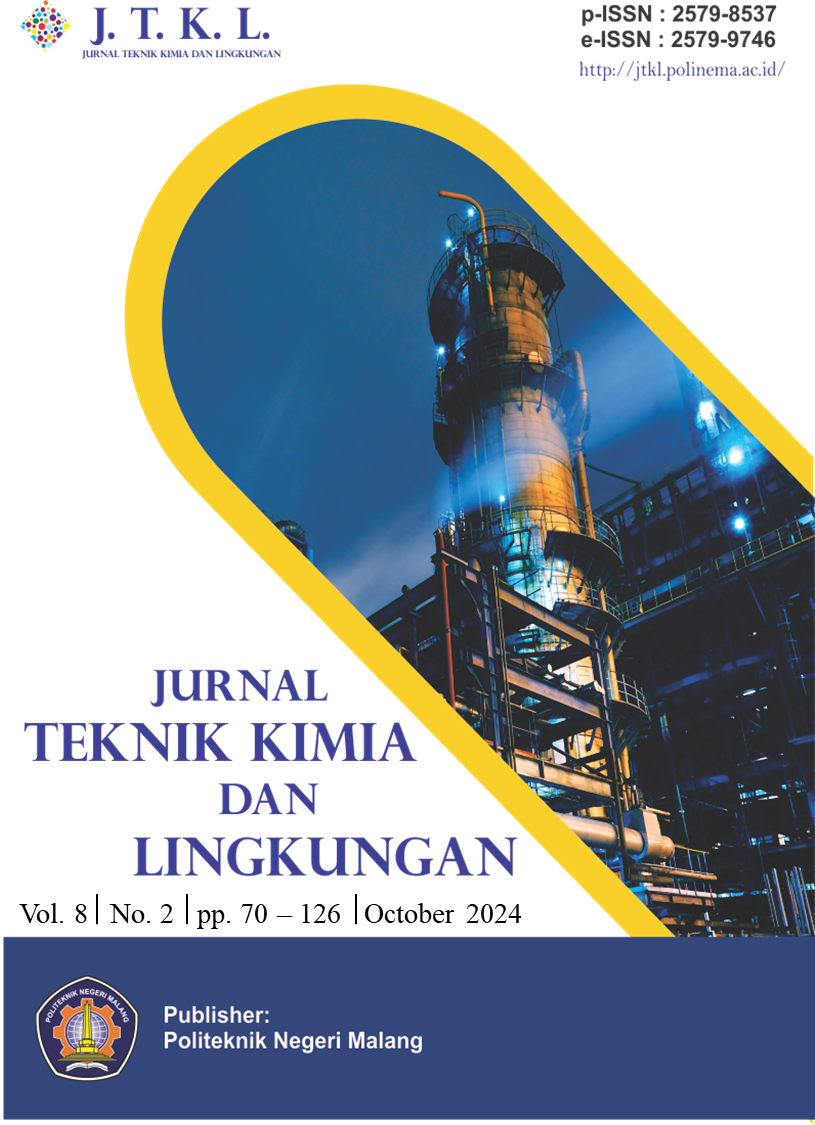Chemical-Thermal Activation to Improve the Characterization of Sludge-Based Activated Carbon (SBAC) from Palm Oil Mill Sludge (POMS)
DOI:
https://doi.org/10.33795/jtkl.v8i2.5104Keywords:
activated carbon, POMS, SBAC, sludgeAbstract
The development of time and technology triggers significant challenges in preserving the environment. Large-scale industry that uses a large quantity of energy and clean water is the main reason environmental management due to industrial activities needs to be considered properly. In addition to liquid wastewater, waste in the form of sludge used in wastewater management is also a new problem that requires special attention. Sludge-based activated carbon (SBAC) is one of the options for utilizing WWTP sludge in low-cost adsorbent materials. The development of SBAC is a promising solution to solving two-way environmental problems. The most used activation method combines thermal and chemical compound impregnation. This paper aims to prove that Palm Oil Mill Sludge (POMS) can be applied as an adsorbent after chemical and thermal activation. KOH 4M was used with a ratio of 1:1 (weight/volume) with pyrolysis heating at 700oC injected with nitrogen gas (N2). Fourier Transform Infrared Spectroscopy (FTIR) test shows SBAC has hydroxyl and carboxyl functional groups, Pore Size Analyzer (PSA) classified SBAC as microporous with 1.7 nm size of SBAC, iodine number is about 821 mg/g, 23.63% of ash content, 62.96% of fixed carbon, 11.5% of water content, and 15.37% of volatile content.
References
M. J. A. Alatabe, A. A. Hussein, Review Paper. Utilization of Low-Cost Adsorbents for the Adsorption Process of Chromium ions., IOP Conf. Ser. Mater. Sci. Eng., vol. 1076, no. 1, pp. 012095, 2021.
A. Bhargava, Activated Sludge Treatment Process-Concept and System Design, Int. J. Eng. Dev. Res., vol. 4, no. 2, pp. 890–896, 2016.
S. Huang, L. Yang, L. Ji, Current Status and Development Trends of Sludge Disposal Technology, E3S Web Conf., vol. 290, pp. 03002, 2021.
Y. Bian, Q. Yuan, G. Zhu, B. Ren, A. Hursthouse, P. Zhang, Recycling of Waste Sludge: Preparation and Application of Sludge-based Activated Carbon, Int. J. Polym. Sci., vol. 2018, no. 1, pp. 8320609, 2018.
Y. Liu, H. Cheng, Y. He, Application and Mechanism of Sludge-Based Activated Carbon for Phenol and Cyanide Removal from Bio-Treated Effluent of Coking Wastewater, Processes, vol. 8, no. 1, pp. 82, 2020.
M. Du, T. Yu, F. Wang, C. Qu, Study on Preparation of Activated Carbon from Sludge, IOP Conf. Ser. Mater. Sci. Eng., vol. 484, no. 1, no. 012013, 2019.
G. Gascó, A. Méndez J. M. Gascó, Preparation of Carbon-based Adsorbents from Sewage Sludge Pyrolysis to Remove Metals from Water, Desalination, vol. 180, pp. 245–251, 2005.
E. M. Anifah, I. K. Ariani, R. N. Hayati, S. A. Nugraha, Adsorption of Oil and Grease in Wastewater using Activated Carbon Derived from Sewage Sludge, IOP Conf. Ser. Earth Environ. Sci., vol. 1098, no. 1, pp. 0123043, 2022.
I. Sierra, U. Iriarte-Velasco, J. L. Ayastuy, A. T. Aguayo, "Production of Magnetic Sewage Sludge Biochar: Investigation of the Activation Mechanism and Effect of the Activating Agent and Temperature", in Biomass Conversion and Biorefinery, vol. 13, pp. 17101-17118, 2023.
P. Budiastuti, R. Mursid, N. A. Y. Dewanti, Analisis Pencemaran Logam Berat Timbal di Badan Sungai Babon Kecamatan Genuk Semarang, J. Kesehat. Masy., vol. 4, no. 5, pp. 119–125, 2016.
C. Tortajada, Contributions of Recycled Wastewater to Clean Water and Sanitation Sustainable Development Goals, npj Clean Water, vol. 3, no. 1, pp. 22, 2020.
A. Betsholtz, S. Jacobsson, S. Haghighatafshar, K. Jönsson, Sewage Sludge-Based Activated Carbon – Production and Potential in Wastewater and Stormwater Treatment, Research Report, Division of Chemical Engineering, Lund University, Sweden, 2018.
N. Nuraini, A. Djulardi, A. Trisna, Palm Oil Sludge Fermented by Using Lignocellulolytic Fungi as Poultry Diet, Int. J. Poult. Sci., vol. 16, no. 1, pp. 6–10, 2017.
M. N. Khairuddin, A. J. Zakaria, I. M. Isa, H. Jol, W. M. Nazri Wan Abdul Rahman, M. K. S. Salleh, The Potential of Treated Palm Oil Mill Effluent (POME) Sludge as an Organic Fertilizer, Agrivita, vol. 38, no. 2, pp. 142–154, 2016.
L. Wang, M. Li, M. Hao, G. Liu, S. Xu, J. Chen, X. Ren, Y. A. Levendis, Effects of Activation Conditions on the Properties of Sludge-Based Activated Coke, ACS Omega, vol. 6, no. 34, pp. 22020–22032, 2021.
A. Aladin, B. Modding, T. Syarif, F. C. Dewi, Effect of Nitrogen Gas Flowing Continuously into the Pyrolysis Reactor for Simultaneous Production of Charcoal and Liquid Smoke, J. Phys. Conf. Ser., vol. 1763, no. 1, pp. 012020, 2021.
Y. A. B. Neolaka, A. A. P. Riwu, U. O. Aigbe, K. E. Ukhurebor, R. B. Onyancha, H. Darmokoesoemo, H. S. Kusuma, Potential of Activated Carbon from Various Sources as a Low-Cost Adsorbent to Remove Heavy Metals and Synthetic Dyes, Results Chem., vol. 5, pp. 100711, 2023.
A. Rahmawati, Adsorpsi Logam Timbal (Pb) Menggunakan Adsorben Eceng Gondok (Eichhornia Crassipes) Termodifikasi Asam Sitrat, Bachelor Thesis, Jurusan Kimia, Fakultas Sains dan Teknologi, Universitas Islam Negeri Maulana Malik Ibrahim, Indonesia, 2020.
N. R. Nurjannah, T. Sudiarti, L. Rahmidar, Sintesis dan Karakterisasi Selulosa Termetilasi sebagai Biokomposit Hidrogel, al-Kimiya: Jurnal Ilmu Kimia dan Terapan, vol. 7, no. 1, pp. 19–27, 2020.
J. A. Karim, Analisis Gugus Fungsi dan Porositas Batuan Menggunakan Metode Fourier Transform Infrared (FTIR) dan Scanning Electron Microscope (SEM) di Toraja, Sulawesi Selatan, Bachelor Thesis, Program Studi Geofisika, Fakultas Matematika dan Ilmu Pengetahuan Alam, Universitas Hasanuddin, Indonesia, 2022.
Y. John, V. E. David Jr., D. Mmereki, A Comparative Study on Removal of Hazardous Anions from Water by Adsorption: A Review, Int. J. Chem. Eng., vol. 2018, no. 1, pp. 3975948, 2018.
C. Tang, J. Guan, Synergistic Preparation of Sludge Carbon from Oily Sludge and Walnut Shells, Int. J. Anal. Chem., vol. 2022, no. 1, pp. 6734039, 2022.
Downloads
Published
Issue
Section
License
Copyright (c) 2024 Dinda Dwiana Inema, Marisa Handajani

This work is licensed under a Creative Commons Attribution-NonCommercial 4.0 International License.







